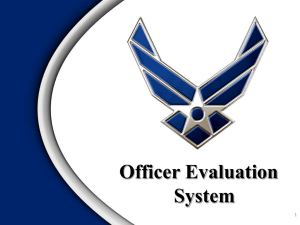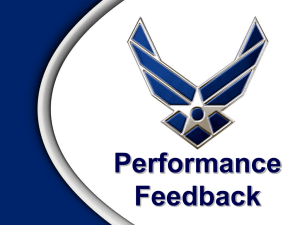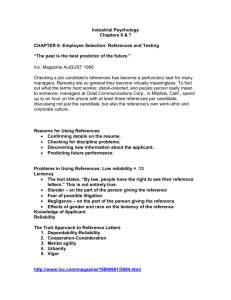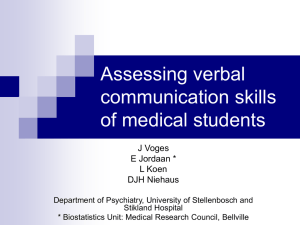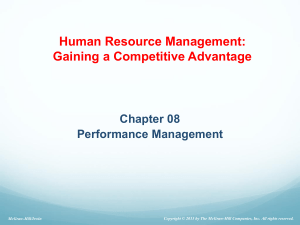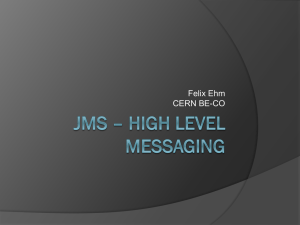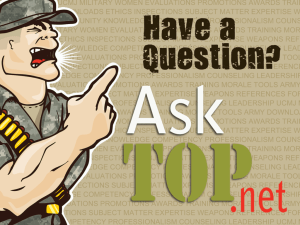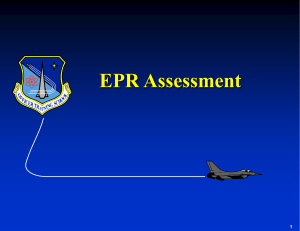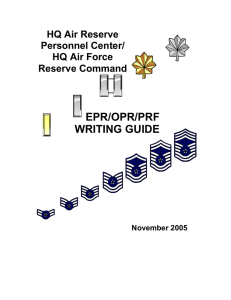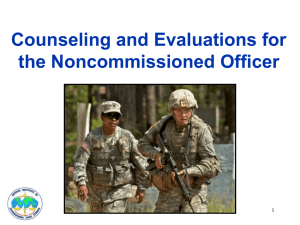Methods for Assessing Safety Culture
advertisement
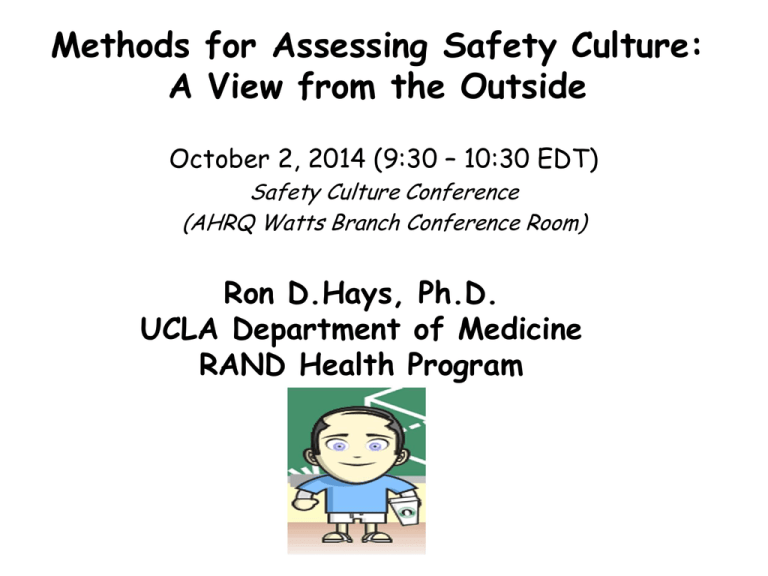
Methods for Assessing Safety Culture: A View from the Outside October 2, 2014 (9:30 – 10:30 EDT) Safety Culture Conference (AHRQ Watts Branch Conference Room) Ron D.Hays, Ph.D. UCLA Department of Medicine RAND Health Program Patient Safety Culture Measures • AHRQ Hospital Survey on Patient Safety Culture (HSOPSC) – http://www.ahrq.gov/legacy/qual/patientsafetyc ulture/hospsurvindex.htm • Safety Attitudes Questionnaire (SAQ) – https://med.uth.edu/chqs/surveys/safetyattitudes-and-safety-climate-questionnaire/ • Patient Safety Climate in Healthcare Organizations (PSCHO) Survey – http://www.midss.org/content/patient-safetyclimate-healthcare-organizations-pscho 2 AHRQ Hospital Survey on Patient Safety Culture (HSOPSC) • 42 items measuring 12 domains – – – – – – – – – – – – Supervisor/manager expectations (k = 4) Organizational learning/Cont. improve (k = 3) Teamwork within units (k = 4) Teamwork across units (k = 4) Communication openness (k = 3) Feedback/comm. about error (k = 3) Non-punitive response to error (k = 3) Staffing (k = 4) Management support for safety (k = 3) Handoffs/transitions (k = 4) Frequency of events reports (k = 3) Overall perceptions of patient safety (k = 4) 3 Safety Attitudes Questionnaire (SAQ) • 30 items measuring 6 domains – Safety climate (k = 7) – Teamwork climate (k = 6) – Perceptions of management (k = 4) – Job satisfaction (k = 5) – Working conditions (k = 4) – Stress recognition (k = 4) 4 Patient Safety Climate in Healthcare Organizations (PSCHO) Survey • 37 items measuring 7 domains – Senior managers’ engagement (k = 7) – Organizational resources (k = 3) – Overall emphasis on patient safety (k = 3) – Unit safety norms (k = 7) – Unit support/recognition for safety effort (k = 4) – Fear of blame (k = 2) – Fear of shame (k = 5) – Provision of safe care (k = 3) 5 – Learning (k = 3) Qualitative Observations (HSOPSC) • Response options Please indicate your agreement or disagreement with the following statements about your work area/unit. Think about your hospital work area/unit… Strongly Strongly Disagree Disagree Neither Agree Agree 1. People support one another in this unit ...................................................... 1 2 3 4 5 2. We have enough staff to handle the workload ........................................... 1 2 3 4 5 3. When a lot of work needs to be done quickly, we work together as a team to get the work done .......................................................................... 1 2 3 4 5 4. In this unit, people treat each other with respect ........................................ 1 2 3 4 5 5. Staff in this unit work longer hours than is best for patient care ................. 1 2 3 4 5 6 Qualitative Observations (SAQ) 7 Qualitative Observations (PSCHO) 8 Reliability Degree to which the same score is obtained when the target or thing being measured (person, plant or whatever) hasn’t changed. Internal consistency (items) Need 2 or more items Test-retest (administrations) Need 2 or more time points Inter-rater (rater) Need 2 or more raters of the thing being measured 9 Reliability Formulas Model Two-way random Twoway mixed Oneway Reliability N ( MSBMS MSEMS ) NMSBMS MS JMS MSEMS MSBMS MSEMS MSBMS MSBMS MSWMS MSBMS Intraclass Correlation MSBMS MSBMS MSEMS (k 1) MSEMS k ( MS JMS MSEMS ) / N MSBMS MSEMS MSBMS (k 1) MSEMS MSBMS MSWMS MSBMS (k 1) MSWMS BMS = Between Ratee Mean Square N = n of ratees WMS = Within Mean Square k = n of items or raters JMS = Item or Rater Mean Square EMS = Ratee x Item (Rater) Mean Square 10 Reliability Formulas Model Two-way random Twoway mixed Oneway Reliability N ( MSBMS MSEMS ) NMSBMS MS JMS MSEMS MSBMS MSEMS MSBMS MSBMS MSWMS MSBMS Intraclass Correlation MSBMS MSBMS MSEMS (k 1) MSEMS k ( MS JMS MSEMS ) / N MSBMS MSEMS MSBMS (k 1) MSEMS MSBMS MSWMS MSBMS (k 1) MSWMS BMS = Between Ratee Mean Square N = n of ratees WMS = Within Mean Square k = n of items or raters JMS = Item or Rater Mean Square EMS = Ratee x Item (Rater) Mean Square 11 Reliability Formulas Model Two-way random Twoway mixed Oneway Reliability N ( MSBMS MSEMS ) NMSBMS MS JMS MSEMS MSBMS MSEMS MSBMS MSBMS MSWMS MSBMS Intraclass Correlation MSBMS MSBMS MSEMS (k 1) MSEMS k ( MS JMS MSEMS ) / N MSBMS MSEMS MSBMS (k 1) MSEMS MSBMS MSWMS MSBMS (k 1) MSWMS BMS = Between Ratee Mean Square N = n of ratees WMS = Within Mean Square k = n of items or raters JMS = Item or Rater Mean Square EMS = Ratee x Item (Rater) Mean Square 12 rwg (i) • 1 – (Sxj2 / sigmaEU2) – Within-group interrater reliability for Xj (Proportion of non-error variance) – Sxj2 = observed variance on Xj – SigmaEU2 = variance on Xj if all judgements were due to random measurement error • Expected error variance based on uniform distribution. • (NCAT2 – 1)/12 • James et al. (1984, J App Psych) 13 Item-scale correlation matrix Item #1 Item #2 Item #3 Item #4 Item #5 Item #6 Item #7 Item #8 Item #9 Depress Anxiety 0.80* 0.80* 0.80* 0.20 0.20 0.20 0.20 0.20 0.20 0.20 0.20 0.20 0.80* 0.80* 0.80* 0.20 0.20 0.20 Anger 0.20 0.20 0.20 0.20 0.20 0.20 0.80* 0.80* 0.80* *Item-scale correlation, corrected for overlap. 14 Item-scale correlation matrix Item #1 Item #2 Item #3 Item #4 Item #5 Item #6 Item #7 Item #8 Item #9 Depress Anxiety 0.50* 0.50* 0.50* 0.50 0.50 0.50 0.50 0.50 0.50 0.50 0.50 0.50 0.50* 0.50* 0.50* 0.50 0.50 0.50 Anger 0.50 0.50 0.50 0.50 0.50 0.50 0.50* 0.50* 0.50* *Item-scale correlation, corrected for overlap. 15 Confirmatory Factor Analysis Item #1 Item #2 Item #3 Item #4 Item #5 Item #6 Item #7 Item #8 Item #9 Depress Anxiety 0.80* 0.80* 0.80* 0.00 0.00 0.00 0.00 0.00 0.00 0.00 0.00 0.00 0.80* 0.80* 0.80* 0.00 0.00 0.00 Anger 0.00 0.00 0.00 0.00 0.00 0.00 0.80* 0.80* 0.80* *Factor loading. 16 Validity Does scale represent what it is supposed to be measuring? • Singer et al. (2009) – Hospitals with better safety climate overall had lower relative incidence of patient safety indicators – Frontline personnel’s (not senior manager’s) perceptions of better safety climate were associated with lower incidence of patient safety indicators 17 New Directions • • • • • Standardized General Population Metric Category Response Curves Computer Adaptive Testing Differential Item Functioning Linking of Different Measures 18 T-score Metric • T Score Mean = 50 SD = 10 Referenced to US “General” Pop. T = 50 + (z * 10) 19 CATEGRORY RESPONSE CURVE Item Responses and Trait Levels Person 1 Item 1 Person 2 Person 3 Item 2 www.nihpromis.org Item 3 Trait Continuum Computer Adaptive Testing (CAT) PROMIS Physical Functioning vs. “Legacy” Measures 10 20 30 40 50 60 70 24 Differential Item Functioning (DIF) • Probability of choosing each response category should be the same for those who have the same estimated scale score, regardless of other characteristics • Evaluation of DIF by subgroups 25 DIF (2-parameter model) 1 Men Probability of "Yes" Response 0.9 0.8 0.7 0.6 Women White 0.5 0.4 Slope DIF Location DIF 0.3 0.2 AA 0.1 0 -4 -3.5 -3 -2.5 -2 I cry when upset -1.5 -1 -0.5 0 0.5 1 1.5 2 2.5 3 3.5 4 I get sad for no reason Higher Score = More Depressive Symptoms 26 Linking of Measures (Etchegaray & Thomas, 2012) • R-squared for SAQ teamwork = 54% 0.83 + 0.34* HSOPSteamwork + 0.51* HSOPScommun. • R-squared for SAQ safety = 42% 1.63 + 0.65* HSOPorganizational learning 27 Linking • Assumes – Instruments are measuring essentially the same thing (unidimensional) • Correlations among SAQ and HSOPS – Etchegaray & Thomas (2012) Table 4 – Predominantly unidimensional • 8.2, 1.28 and 0.96 are 1st 3 principal components – If two factors rotated 2nd factor shows common variance among 5 HSOPS scales • Teamwork within, non-punitive, number of events reported, expectations, and staffing 28 Linking • Assumes – Instruments are measuring essentially the same thing (unidimensional) – Scores from the two instruments are highly correlated (> 0.80); compare actual with estimated scores – Subgroup invariance (standardized root mean square deviation) • Equipercentile linking of scores – Scores associated with equivalent % ranks • IRT linking 29 drhays@ucla.edu (310-794-2294). Bibliography DiCuccio, M. H. (2014). The relationship between patient safety culture and patient outcomes: A systematic review. J Patient Saf, epub. Etchegary, J. M., & Thomas, E. J. (2012). Comparing two safety culture surveys: Safety Attitudes Questionnaire and Hospital Survey on Patient Safety. BMJ Qual Sat, 21, 490-498. Morello, R. T. et al. (2013). Strategies for improving patient safety culture in hospitals: A systematic review. BMJ Qual Saf, 22, 11-18. Sammer, C. E., Lykens, K., Singh, K. P., Mains, D. A., & Lackan, N. A. (2010). What is patient safety culture? A review of the literature. Journal of Nursing Scholarship, 42, 156-165. Sexton, J. B. et al. (2011). Assessing and improving safety climate in a large cohort of intensive care units. Crit Care Med, 39, 934-939. Sexton, J. B. et al. (2006). The Safety Attitudes Questionnaire: Psychometric properties, benchmarking data, and emerging research. BMC Health Services Research, 6, 44. Singer, S. et al. (2009). Relationship of safety climate and safety performance in hospitals. Health Services Research, 44, 399-421. Singer, S. et al. (2007). Workforce perceptions of hospital safety culture: Development and validation of the Patient Safety Climate in Healthcare Organizations Survey. Health Services Research, 42, 1999-2021 Sorra, J. S., & Dyer, N. (2010). Multilevel psychometric properties of the AHRQ hospital survey on patient safety culture. BMC Health Services Research, 10, 199. 31
